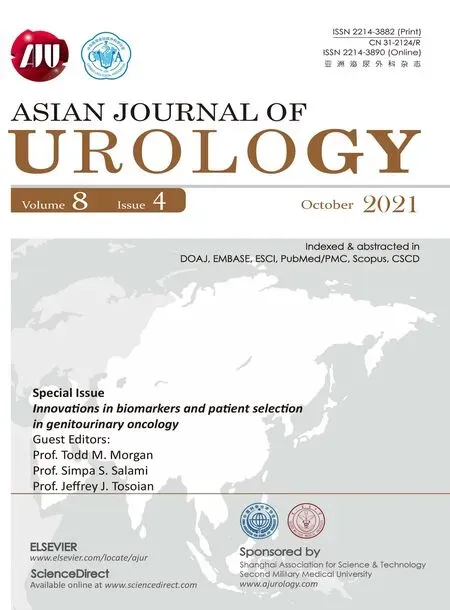Progress and challenges in testicular cancer microRNAs
Testicular germ cell tumors(GCTs)are malignancies that can be histologically distinguished as seminomatous testicular germcell tumors(SGCTs)ornonseminomatous testiculargerm cell tumors(NSGCTs).The primary treatment of testicular GCTs is orchiectomy which can be followed with adjuvant radiotherapy,platinum-based chemotherapeutics,and/or retroperitoneal lymph node dissection(RPLND)based on clinical staging of disease and patient risk stratification[1].The measurement of serum tumor markers(STMs)is integral to the diagnosis and monitoring of GCTs[2].Currently,three STMs are used for clinical monitoring:Alpha-fetoprotein(AFP),human chorionic gonadotrophin(hCG),and lactate dehydrogenase(LDH).However,conventional STMs offer limited performance characteristics due to only being elevatedin<60%ofGCTcaseswithsensitivitybeing especially poor in the case of occult disease and certain GCT subtypes,i.e.seminoma and teratoma[3].There remains a need to improve current diagnostic approaches to avoid subjecting patients to the side effects of over-or under-treatment[4].Further,STM elevation can be associated with variables unrelated to GCTs such as liver disease and hypogonadism[5].These limitations have engendered the need to identify additional blood-based biomarkers that offer superior performance in clinical scenarios where STMs have fallen short.
Recently,microRNAs(miRNAs)have emergedas one of the most promising options to fill this demand.MiRNAs are small non-coding RNA sequences that negatively regulate gene expression.Due to their tissue specific expression and stable presence in blood serum,they are considered an attractive biomarker in the detection and monitoring of certain cancers including GCTs[6].Of the various embryonic stem cell miRNAs associated with GCTs,miR-371a-3p has the best performance characteristics with multiple studies indicating sensitivity and specificity up to 90.0%and 93.4%,respectively[7].MiR-371a-3p boasts a shorter half-life of 3.6-7.0 h compared to classic STMs like AFP which has a half-life of about 5-7 days.This suggests better temporal resolution in monitoring changes to disease progression[7].While collectively such evidence supports miR-371a-3p as a robust biomarker for GCTs,continued investigation is necessary to determine which clinical contexts it will best serve.
In this issue of Asian Journal of Urology,Ahmadi et al.[8]provide a comprehensive literature review covering the utility of miRNAs in the clinical management of GCTs while also giving sound considerations to the limitations these biomarkers possess.Particularly,the performance of miR-371a-3p is highlighted in the context of various relevant clinical scenarios such as early risk stratification and prediction of recurrence.Regarding diagnostic applications,the authors reference multiple studies surrounding the outstanding performance of miR-371a-3p to accurately identify SGCTs and non-teratoma NSGCTs with sensitivity and specificity metrics that exceed STMs.Additional prospective studies associating elevated miR-371a-3p to disease recurrence have also led to ongoing clinical trials such as SWOG1823 and AGCT1531 which look to provide validity of miRNA use in GCT management.
The discovery of a more sensitive marker for diagnosing early stage GCTs spells great news for personalized patient care.First off,miR-371a-3p would be the first robust biomarker for detection of pure SGCT where hCG is elevated in only 15%-20% of seminoma cases.A reliable SGCT marker has important implications for diagnosis,early detection of recurrence,treatment monitoring,and surveillance-especially since teratoma is not a consideration for post chemotherapy in SGCT.Among early stage SGCT and NSGCT patients with normal STM levels but elevated miR-371a-3p,earlier interventions could result in decreased treatment burden.This underlines a major avenue by which miR-371a-3p could be integrated into a diagnostic panel with current conventional markers to improve early decision making in patients with GCTs.
As promising as miRNAs appear to be for care management,the authors exercise appropriate caution by mentioning the limitations of these novel biomarkers.Given that neither miR-371a-3p nor existing markers candetect teratoma,additional studies are still required to find a biomarker for this tumor subtype[9].Another issue cited is the need to standardize circulating miRNA processing across laboratories.The article cites multiple points of variation in miRNA isolation protocol including differences in collection,extraction source(i.e.,plasma or serum),and ideal reference gene.Such issues of interlaboratory variations were partly addressed in a systematic review and meta-analysis by Liu et al.[10]which pooled data from six separate studies spanning three countries.All studies included investigated miR-371-3p performance in detecting viable GCT.While results indicated that laboratory location significantly contributed to heterogeneity,overall pooled performance characteristics were still high at 0.90 sensitivity and 0.93 specificity.Although miR-371-3p does maintain impressive performance despite heterogeneity,future efforts should be made to obtain interlaboratory concordance prior to implementation in clinical settings.
Author contributions
Drafting of manuscript:Bendu K.Konneh,John T.Lafin,Aditya Bagrodia.
Critical revision of the manuscript:Bendu K Konneh,John T.Lafin,Aditya Bagrodia.
Conflicts of interest
The authors declare no conflict of interest.
 Asian Journal of Urology2021年4期
Asian Journal of Urology2021年4期
- Asian Journal of Urology的其它文章
- Radical cystoprostatectomy with orthotopic neobladder for a case of treatment emergent neuroendocrine prostate cancer presenting as bladder mass with hematuria-a rare instance of tumor remission after local control
- Late upper urinary tract urothelial carcinoma following radical cystectomy,presenting as page kidney
- Metachronous chest wall metastasis from clear cell renal cell carcinoma-A rarity
- Perioperative anticoagulation and open distal corpora cavernosa shunt in the management of a case of stuttering idiopathic persistent childhood ischaemic priapism
- Effect of tamsulosin versus tamsulosin plus tadalafil on renal calculus clearance after shock wave lithotripsy:An open-labelled,randomised,prospective study
- A novel spherical-headed fascial dilator is feasible for second-stage ultrasound guided percutaneous nephrolithotomy:A pilot study
